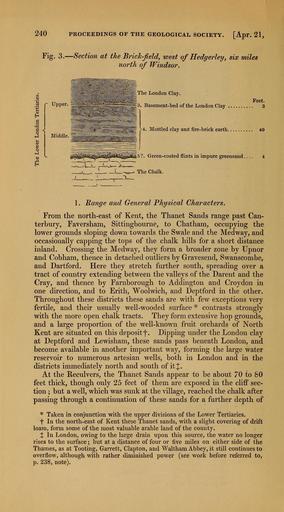MAKE A MEME
View Large Image

| View Original: | The_Quarterly_journal_of_the_Geological_Society_of_London_(12684235975).jpg (1773x3200) | |||
| Download: | Original | Medium | Small | Thumb |
| Courtesy of: | commons.wikimedia.org | More Like This | ||
| Keywords: The Quarterly journal of the Geological Society of London (12684235975).jpg 240 PROCEEDINGS OF THE GEOLOGICAL SOCIETY Apr 21 <br> Fig 3 � Section at the Brick-field west of Hedgerley six miles <br> north of Windsor <br> The London Clay <br> Feet <br> ~3 Basement-bed of the London Clay 3 <br> 4 Mottled clay and fire-brick earth 40 <br> 5 Green-coated flints in impure greensand 4 <br> The Chalk <br> 1 Range and General Physical Characters <br> From the north-east of Kent the Thanet Sands range past Can- <br> terbury Faversham Sittingbourne to Chatham occupying the <br> lower grounds sloping down towards the Swale and the Med way and <br> occasionally capping the tops of the chalk hills for a short distance <br> inland Crossing the Medway they form a broader zone by Upnor <br> and Cobham thence in detached outliers by Gravesend Swanscombe <br> and Dartford Here they stretch further south spreading over a <br> tract of country extending between the valleys of the Darent and the <br> Cray and thence by Farnborough to Addington and Croydon in <br> one direction and to Erith Woolwich and Deptford in the other <br> Throughout these districts these sands are with few exceptions very <br> fertile and their usually well-wooded surface contrasts strongly <br> with the more open chalk tracts They form extensive hop grounds <br> and a large proportion of the well-known fruit orchards of North <br> Kent are situated on this deposit f Dipping under the London clay <br> at Deptford and Lewisham these sands pass beneath London and <br> isecome available in another important way forming the large water <br> reservoir to numerous artesian wells both in London and in the <br> districts immediately north and south of it <br> At the Reculvers the Thanet Sands appear to be about 70 to SO <br> feet thick though only 25 feet of them are exposed in the cliff sec- <br> tion ; but a well which was sunk at the village reached the chalk after <br> passing through a continuation of these sands for a further depth of <br> Taken in conjunction with the upper divisions of the Lower Tertiaries <br> f In the north-east of Kent these Thanet sands with a slight covering of drift <br> loam form some of the most valuable arable land of the county <br> X In London owing to the large drain upon this source the water no longer <br> rises to the surface ; but at a distance of four or five miles on either side of the <br> Thames as at Tooting Garrett Clapton and Waltham Abbey it still continues to <br> overflow although with rather diminished power see work before referred to <br> p 238 note 35461288 109911 51125 Page 240 Text v 8 http //www biodiversitylibrary org/page/35461288 1852 Geological Society of London Biodiversity Heritage Library The Quarterly journal of the Geological Society of London v 8 1852 Geology Periodicals Smithsonian Libraries bhl page 35461288 dc identifier http //biodiversitylibrary org/page/35461288 smithsonian libraries Information field Flickr posted date ISOdate 2014-02-21 Check categories 2015 August 26 CC-BY-2 0 BioDivLibrary https //flickr com/photos/61021753 N02/12684235975 2015-08-27 12 51 37 cc-by-2 0 PD-old-70-1923 The Quarterly journal of the Geological Society of London 1852 Photos uploaded from Flickr by Fæ using a script | ||||